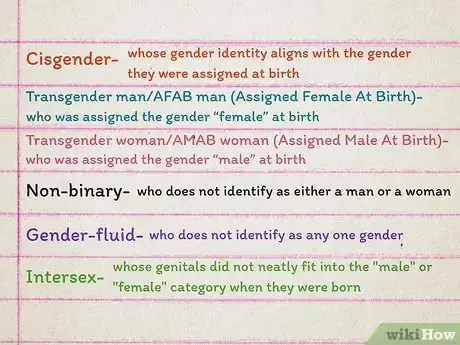wikiHow is a “wiki,” similar to Wikipedia, which means that many of our articles are co-written by multiple authors. To create this article, volunteer authors worked to edit and improve it over time.
There are 17 references cited in this article, which can be found at the bottom of the page.
This article has been viewed 23,961 times.
Learn more...
It takes time to understand yourself, so it's natural to be unsure about their gender identity. People generally know their gender identity from a young age and find it difficult to think of themselves in any other way. Those who think of themselves as other genders, on the other hand, may have difficulty understanding their gender, which can cause a lot of stress and anxiety. This article will help you to understand some of the ways you can become more in touch with your true gender identity and better understand yourself.[1]
Steps
Understanding Gender
-
1Know what assigned sex is. Assigned sex is a label given to you at birth based on medical factors such as hormones, chromosomes, and genitals. Sex is a label — male, female, or intersex — that is assigned to you by a doctor at birth based on your genitals and chromosomes. It's commonly believed that a person's assigned sex determines their gender, but this is not always the case. [2] [3]
- Assigned Female at Birth is referred to as AFAB.
- Assigned Male at Birth is referred to as AMAB.
- Assigned Intersex at Birth is referred to as AIAB.
- Assigned Gender at Birth is referred to as AGAB.
-
2Understand gender identity. Gender identity is about how we see ourselves in terms of gender. Gender identity refers to an individual's internal sense of self and gender, whether they are a man, a woman, neither, or both. Gender identity, unlike gender expression, is not visible to others, and is an internal sense. Common gender identities include: [4]
- Cisgender, or simply cis, is a term that refers to a person whose gender identity corresponds to the sex assigned to them at birth.
- Transgender, or trans, is an umbrella term that refers to someone whose gender identity differs from the gender assigned at birth. (Being intersex is not the same as being nonbinary or transgender.)
- Agender is an adjective that can be used to describe someone who does not identify as any gender.
- Nonbinary/genderqueer is a term that can be used by people who do not identify as male or female or who do not fit into the categories of man or woman. A variety of terms are used to describe these experiences; nonbinary and genderqueer are two examples.
- Genderfluid is a term used to describe individuals whose gender identity (the gender with which they most identify) is not fixed. It can change over time or from one day to the next. Fluid is a type of gender identity or expression, not a sexual orientation.
- Demiboy/Demigirl/Demigender are gender identity terms meaning having a partial, but not complete, attachment to a specific gender identity or to the concept of gender (for example, a boy feeling a partial connection to being a girl, but still identifying as a boy). This is considered a nonbinary gender.
- Bigender is a term for someone who identifies as man and woman, or two genders.
- Trigender is a label used for somebody who identifies with three genders.
- Pangender refers to a multigender non-binary gender identity referring to a vast and diverse multiplicity of genders in the same individual that can extend infinitely, always within the person's own culture and life experience, and may or may not include unknown genders.
Advertisement -
3Understand gender expression. Your gender expression is the manner in which you present your gender. Gender expression can be expressed through clothing, appearance, and behavior. Because others can see it, this is an external sense. These cues are identified as masculine or feminine by society, though what is considered masculine or feminine changes over time and varies by culture.[5]
-
4Understand the difference between sexuality and gender. Gender identity refers to a person's internal sense of gender, whether male, female, or outside of the gender binary. Sexual/romantic orientation refers to a person's physical, emotional, or romantic attraction to other people.[6]
Understanding Yourself and Experimenting
-
1Ask yourself questions. Asking yourself questions about your gender can relieve some confusion and help you better understand yourself. Try asking yourself these questions: [7]
- How do you feel about your birth gender?
- What gender do you wish people saw you as?
- How would you like to express your gender?
- What pronouns do you feel most comfortable using?
- When you imagine your future, what gender are you?
-
2Experiment with different labels. Try out various labels for yourself, such as gender fluid, nonbinary, cisgender, demigender, and transgender, and see how you feel about them. If you don't like a certain label, try another one on and see how you feel until you find one that makes you happy and comfortable.
- It's okay if you don't want to wear a label.
-
3Find out how you're comfortable presenting. This is where gender expression comes into gender. Wearing masculine/feminine clothing doesn't imply that you are a boy/girl, but the way you dress and present can give you insight on your gender. If you enjoy wearing dresses, skirts, or bright colors, this could indicate that you enjoy presenting yourself as feminine. Perhaps you prefer a t-shirt and jeans to a fancy dress—this could indicate that you prefer to dress masculinely. You may prefer a combination of these styles, or you may prefer neither.
- Remember; gender expression does not always correspond to gender identity.
- To deal with dysphoria and feel better about your body, you may want to bind your chest, tuck and tape, pack, or stuff your bra.
-
4Learn more about gender. Look for articles, books, fiction, blogs, music, shows, and video games about gender identities, expression, and labels. The more information you have, the better you can understand yourself. There are numerous online resources available to help you learn more about gender, such as:
- GenderSpectrum.org
- GLAAD
- The Trevor Project Resource Center
-
5Experiment with different pronouns. Apart from our names, pronouns are how we identify ourselves. Pronouns are how someone addresses you in a conversation or discussion. A few sets of pronouns include:
- She/her/hers
- He/him/his
- They/them/theirs
- A combination of pronouns, such as "he/they" or "ze/she/they"
- Neopronouns, such as "ze/hir/hirs" or "xe/xem/xyrs"
- All pronouns, used respectfully.
- You might prefer no pronouns, and request that others only use your name to address you.
Taking Care of Yourself and Finding Support
-
1Practice self care. Self-care simply refers to being aware of your own needs in order to better support those you care about. Ways to take care of yourself:
- Exercise regularly.
- Eat nutritious foods.
- Get enough good quality sleep.
- Do what you enjoy.
-
2Cope with dysphoria. Gender dysphoria is the distress and discomfort that a person experiences when their assigned gender does not match their gender identity. They may also experience distress or discomfort as a result of the traditional gender roles that their assigned gender is expected to play. When people do not feel free to express their gender identity, it can cause something called dysphoria and increase the risk of mental and physical health problems, such as depression, anxiety, and increase suicidal thoughts.[8]
- Gender dysphoria can be an excellent opportunity to pause, take a deep breath, and remind yourself of the things you appreciate about your body. Even something as simple as telling yourself, "I like my feet because they carry me where I want to go," can make you feel a little better.
- Changing the way you think or dress can help you with dysphoria. Read How to Deal with Your Period As a Transgender or Nonbinary Person for tips on handling your period as a trans person, or visit How to Cope with Not Being Able to Transition for tips.
-
3Seek professional assistance if you need it. Gender identity issues are not a mental illness or disorder. However, if you believe you are having difficulties with your mental health, you can seek help from a therapist, a counselor, or someone who specializes in gender and gender dysphoria, such as gender therapy. [9]
- If you need crisis support or you are considering suicide, text/call the Trevor Project hotline.
-
4Create a network of people who validate your gender identity, even if you don't know how to express it yet. If you don't have people like this in your life, think about joining an online support group.[10] What is most important to remember is that you are not alone. Even if you aren't out to your family, friends, or local community, there are a multitude of online resources you can use to connect with other trans, gender diverse, and nonbinary people who share your feelings. [11]
- Usually, people struggle with family and societal expectations when they try to establish their gender identity.
- It is necessary to find support, acceptance, and love when you are going through the coming out process.[12]
- The process can take many years because it takes a long time to explore your identity.[13]
-
5Be patient with yourself. Understanding yourself takes time, and it is normal to change your mind about how you define and express your gender identity several times before things 'feel right' for you. It takes time to understand yourself, so it's natural for some people to be unsure about their gender identity.
Community Q&A
-
QuestionI was assigned female at birth, but I like using he/they pronouns. I like being a girl a little, but I also wanna be a boy. What do I do?
 NicoTop AnswererTry to experiment with different labels and see what you are comfortable with—it’s possible you could be demiboy or bigender. Remember that being a guy doesn’t matter if you like being feminine, but you still want to be a guy, you can be a feminine guy and use he/they pronouns.
NicoTop AnswererTry to experiment with different labels and see what you are comfortable with—it’s possible you could be demiboy or bigender. Remember that being a guy doesn’t matter if you like being feminine, but you still want to be a guy, you can be a feminine guy and use he/they pronouns. -
QuestionCan online tests and quizzes determine your gender?
 NicoTop AnswererSometimes, but not always. A lot of online quizzes are made by people with personal experience who question(ed) their gender, and not by experts. It's better to go to a gender therapist or gender identity center and work with an expert to understand your gender if your having trouble determining your gender.
NicoTop AnswererSometimes, but not always. A lot of online quizzes are made by people with personal experience who question(ed) their gender, and not by experts. It's better to go to a gender therapist or gender identity center and work with an expert to understand your gender if your having trouble determining your gender. -
QuestionI'm AFAB, sometimes it feels great and sometimes I just want to be and to look like a man. Am I genderfluid? How do I cope with gender expression and dressing?
 NicoTop AnswererYou might be genderfluid, but you might also just enjoy dressing masculinely or as a guy. (See more in How to Know if You Are Genderfluid). As for "coping" with gender expression, don't worry about what other people think of you, simply dress in ways that make you feel comfortable and confident.
NicoTop AnswererYou might be genderfluid, but you might also just enjoy dressing masculinely or as a guy. (See more in How to Know if You Are Genderfluid). As for "coping" with gender expression, don't worry about what other people think of you, simply dress in ways that make you feel comfortable and confident.
References
- ↑ https://kidshelpline.com.au/teens/issues/gender-identity
- ↑ https://www.plannedparenthood.org/learn/gender-identity/sex-gender-identity
- ↑ https://kidshelpline.com.au/teens/issues/gender-identity
- ↑ https://kidshelpline.com.au/teens/issues/gender-identity
- ↑ https://www.npr.org/2021/06/02/996319297/gender-identity-pronouns-expression-guide-lgbtq
- ↑ https://www.verywellmind.com/gender-dysphoria-5085081
- ↑ https://www.thetrevorproject.org/resources/category/gender-identity/
- ↑ https://www.psychiatry.org/patients-families/gender-dysphoria/what-is-gender-dysphoria#
- ↑ https://www.nhs.uk/live-well/healthy-body/trans-teenager/
- ↑ https://kidshelpline.com.au/teens/issues/gender-identity
- ↑ https://queersforacause.com/lgbtq%2B-tips/f/gender-dysphoria-5-self-care-tips-to-reduce-dysphoria-symptoms
- ↑ https://www.plannedparenthood.org/learn/sexual-orientation/sexual-orientation/whats-coming-out
- ↑ https://www.plannedparenthood.org/learn/sexual-orientation/sexual-orientation/whats-coming-out
- https://kidshelpline.com.au/teens/issues/gender-identity
- https://www.plannedparenthood.org/learn/gender-identity/sex-gender-identity
- https://www.verywellmind.com/gender-dysphoria-5085081
- https://www.nhs.uk/live-well/healthy-body/trans-teenager/
- https://www.teenvogue.com/story/how-to-figure-out-gender-identity
- https://www.thetrevorproject.org/resources/category/gender-identity/
- https://queersforacause.com/lgbtq%2B-tips/f/gender-dysphoria-5-self-care-tips-to-reduce-dysphoria-symptoms
- https://gender.fandom.com/wiki/Gender_Wiki


















-Step-16.webp)



-Step-26.webp)
-Step-16.webp)
















































